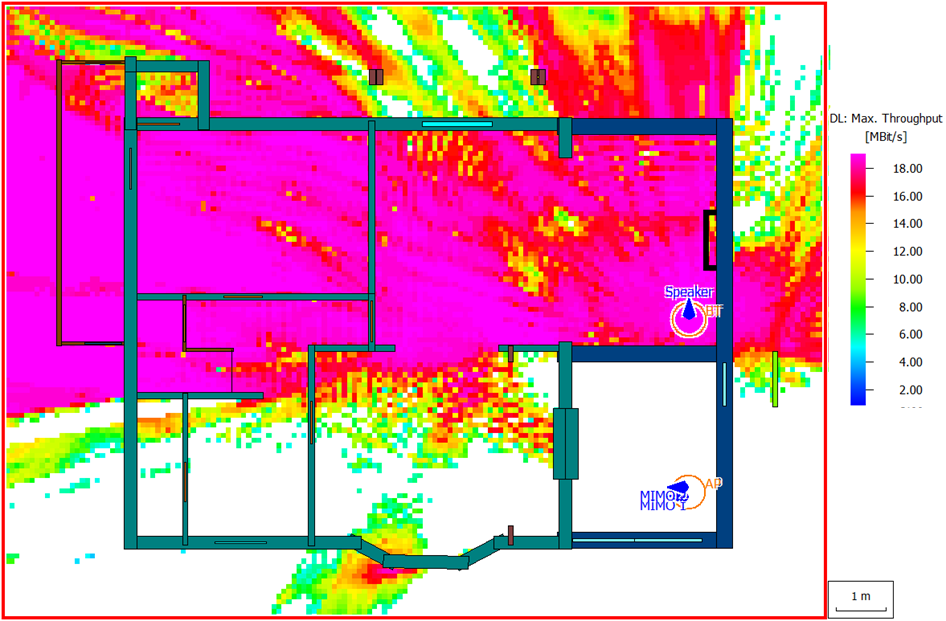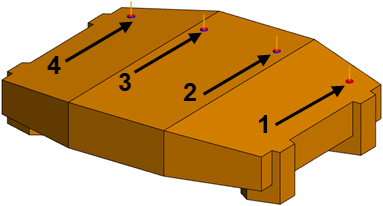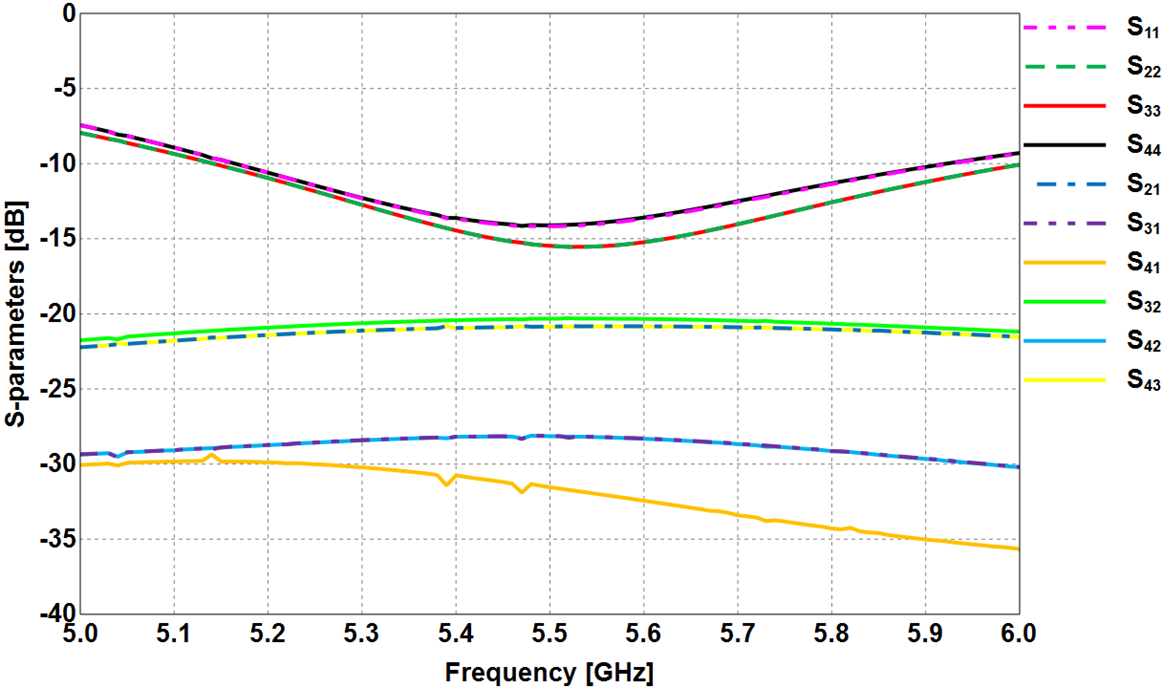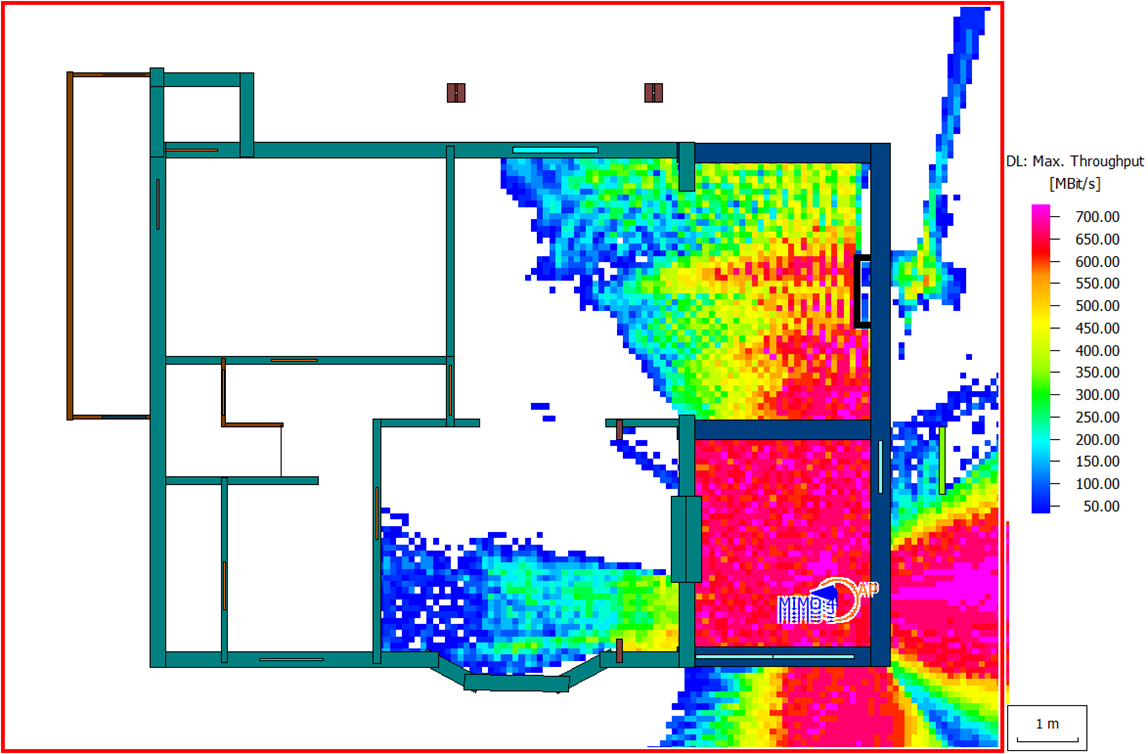Interference between Bluetooth 5 and 802.11n
As 802.11n supports Multiple Input Multiple Output (MIMO) systems, a router with two antennas is used for the analysis where each antenna carries one data stream in a 2x2 MIMO scenario. The radiation patterns of the router antennas at the 2412 MHz carrier frequency are showed in Figure 20.
Figure 20. Radiation patterns of the two antennas for the 2x2 MIMO router at 2412 MHz.
The router antennas are well matched for the 2.4 GHz Wi-Fi frequency bands, as shown in Figure 21 (a). For MIMO, it is not only required for the antennas to be well matched at the carrier frequency but also well isolated to avoid interstream interference between the data streams. It is clearly illustrated in Fig. 21 (a) that the two antennas have good isolation (~25 dB isolation), but a true indication of the independent behavior of the antennas is the Envelope Correlation Coefficient (ECC), as shown in Figure 21 (b). An ECC value of 0.5 is ok, higher than 0.5 is considered bad, and 0.3 or less is considered pretty good for MIMO applications.

Figure 21. Matching and isolation plots of Wi-Fi router: (a) S-parameter data and (b) Envelope correlation coefficient plot.
The 802.11n being an OFDM technology using Time Division Duplex (TDD) separation, the maximum achievable throughput will be the same as the maximum achievable data rate. From the Figure 22, it is clear that having the access point in the corner of the room next to the living room will provide good coverage for most part of the house.

Figure 22. Maximum achievable throughput with the 802.11n Wi-Fi technology inside the residential building.
The Wi-Fi is operating on the 2412 MHz carrier with the Bluetooth on 2442 MHz. Apart from the two carriers being close to each other, they are also physically located closely inside the house. This leads to a drop in the Bluetooth throughput because of the leakage from Wi-Fi into the Bluetooth frequency band, especially in the areas close to the Wi-Fi router, as shown in Figure 23.
 Figure 23. Effect of Wi-Fi on the Bluetooth throughput. White space near the Wi-Fi router indicates the drop in Bluetooth coverage due to the interference.
Figure 23. Effect of Wi-Fi on the Bluetooth throughput. White space near the Wi-Fi router indicates the drop in Bluetooth coverage due to the interference.
The interference from Wi-Fi on the Bluetooth can be mitigated by considering additional filtering in the Bluetooth module. When the interference due to leakage from Wi-Fi is attenuated by additional 20 dB with better filtering, the Bluetooth throughput is improved reasonably, as shown in Figure 24.

Figure 24. Bluetooth throughput with additional attenuation of leakage from Wi-Fi.
Interference between Bluetooth 5 and 802.11ax
The 802.11ax technology is introduced to provide higher data rates than its predecessor 802.11ac and, as such, supports several transmission modes like BPSK, QPSK. 16 QAM, 64 QAM and 256 QAM. The 802.11ax operates in the 5 GHz frequency band and supports up to 8x8 MIMO. However, there are not many user equipment supporting eight data streams and as such a four-antenna router is chosen for this study, as shown in Figure 25.

Figure 25. Four antenna Wi-Fi router for 802.11az protocol.
With the S11 being less than -10 dB, all the four antennas of the router are well matched over the entire 5 GHz Wi-Fi frequency bands. Not only matching, these antennas exhibit good isolation between them for MIMO operation, as shown in Figure 26.

Figure 26. S-parameters of the four-antenna router.
The 5 GHz band supports higher bandwidths that help in achieving the higher data rates. This is evident from the increased maximum achievable throughput from 18 MBps for 802.11n (Figuer 23) to 700 MBps as shown in Figure 27(a). However, these high frequency signals are attenuated much more than the 2.4 GHz signals used for 802.11n because of the shorter wavelength. As a result, the Wi-Fi router with 802.11ax technology can provide the coverage only for a section of the house close to the access point as seen in Figuer 27 (a). The router in this case is operating on the 5530 MHz carrier with the four antennas supporting four individual data streams in 4x4 MIMO scenario. From this analysis, it is evident that while higher data rates are achieved using the 5 GHz frequency bands, this comes at the expense of limited coverage. As such, one could use the 2.4 GHz frequency bands for broader coverage while using the 5 GHz bands for better speed, which is common in the present-day Wi-Fi access points. One could also use repeaters when operating on the 5 GHz bands to provide a broader coverage, as illustrated in Figuer 27(b).

(a)
 (b)
(b)
Figure 27. Maximum achievable DL throughput of 802.11 ax inside the house: (a) Without repeater, (b) With repeater.
Another advantage of using the 5 GHz frequency bands for the Wi-Fi is its non-interference with the 2.4 GHz Bluetooth, as shown in Figure 28. As illustrated, the Wi-Fi access point has minimal effect on the Bluetooth throughput.

Figure 28. Bluetooth throughput when considering the leakage from the 5 GHz Wi-Fi access point.
V. Conclusions
In this paper, the simulation-driven virtual prototyping techniques are introduced into the smart product’s development cycle to reduce the development time and ensure intrinsic qualities of the smart product. Specifically, the techniques are coupled with the three different development stages of the wireless speaker: PCB layout, antenna design and integration, and wireless coverage and interference evaluation.
In the PCB layout stage, the PCB design considerations for the smart product’s electric performance are discussed and the corresponding PCB layouts are verified by the design rule checker, DFE and closely studied by the SI and thermal analysis. Thanks to the verification and analysis process, it is illustrated to maximize audio quality and high-speed data rate of the smart product at the PCB design step.
In the antenna design and integration stage, a meander-line antenna is designed and integrated on the PCB by optimizing antenna shape and using a matching circuit. It is also discussed in detail that virtual simulations of PCB with antenna for placement in optimal location inside a speaker cabinet considering the neighboring electrical and mechanical components for the best antenna performance possible.
In the wireless coverage and interference stage, the Bluetooth performance of the smart speaker inside a house are evaluated in terms of wave propagation and network parameters. In addition, co-existence situations of the smart speaker with nearby wireless devices in a real life are analyzed by considering the various Bluetooth and Wi-Fi air interface standards.
In conclusion, the simulation-driven virtual prototyping is an essential solution to make the smart products more cost-effective, high quality, and reliable from the early development stage. According to the market trends, cost reduction, compact size, and seamless connectivity of smart wireless products become increasingly required. To satisfy the market requirements, the simulation-driven design and virtual prototyping should be readily and widely coupled with the development process of the modern electrical and mechanical products.
References
- White paper: Innovations for new business opportunities – 5G-PPP: https://5g-ppp.eu/wp-content/uploads/2017/01/5GPPP-brochure-MWC17.pdf
- Ulf Sellgren, “Simulation-Driven Design – Motives, Means, and Opportunities”, Doctoral Thesis, The Royal Institute of Technology, 1999.
- Slawomir Koziel, Xin-She Yang, and Qi-Jun Zhang, “Simulation-Driven Design Optimization and Modeling for Microwave Engineering”, Singapore, 2013.
- G. Gary Wang, “Definition and Review of Virtual Prototyping”, ASME Journal of Computing and Information Science in Engineering, Vol. 2, No. 3, pp. 232-236, 2002.
- M. A. Erstina, "Design and Construction of Wireless Speaker Using Bluetooth." African Journal of Applied Research, Vol. 1, No. 1, pp. 413-426, 2016.
- Altair PollEx: https://www.altair.com/pollex/
- Universal Serial Bus Specification, April 2000.
- J. Rashed and C. T. Tai, “A new class of resonant antennas”, IEEE Trans. Antennas Propagat., Vol. 39, pp. 1428–1430, Sept. 1991.
- Altair Feko: https://www.altair.com/feko/
- S. R Best and J. D. Morrow, “Limitations of Inductive Circuit Model Representations of meander line antennas”, IEEE Trans. Antennas and Propagation Society, International Symposium, vol. 1, pp 852-855, June 2003.
- Ulf Wetzker, Ingmar Splitt, Marco Zimmerling, Carlo Alberto Boano and Kay Römer, “Troubleshooting Wireless Coexistence Problems in the Industrial Internet of Things,” IEEE Int. Conf. on Computational Science and Eng, Paris, France, 2016.
- Bluetooth core specification version 5.0: http://www.bluetooth.com.
- 802.11b standard core specifications: https://standards.ieee.org/standard/802_11b-Cor1-2001.html.
- 802.11n standard core specifications: https://standards.ieee.org/standard/802_11n-2009.html.
- Evgeny Khorov, Anton Kiryanov, Andrey Lyakhov, and Giuseppe Bianchi, “A Tutorial on IEEE 802.11ax High Efficiency WLANs,” IEEE Comm. Surveys & Tutorials, Vol. 21, No. 1, First Quarter 2019.
